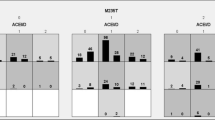Abstract
This study was carried out in 52 non-diabetic, 62 diabetic patients with coronary artery disease (CAD) and 55 controls. A Gly to Ser change RAGE gene was analyzed by PCR-RFLP techniques. GlyGly genotype frequency is higher in non-diabetics versus controls (P < 0.001). GlySer frequency is higher in diabetics than controls and non-diabetics (P < 0.001). Ser allele frequency is respectively increased in the order of diabetics > Controls > non-diabetics. These results reveals none association between Gly82Ser and the development of disease in non-diabetic patients. In diabetics with Ser allele, higher prevalence of left-ventricule-hypertrophy was observed, but the significant difference between Gly82Ser and left-ventricule-hypertrophy only found in the whole patient group. As a result Ser allele has much more importance in the development of left-ventricule-hypertrophy than other cardiovascular risk factors. In this study we found the presence of Gly allele contributes to the CAD in non-diabetics and Ser allele may contribute to disease in diabetics.
Similar content being viewed by others
References
Gerszten RE, Rosenzweig A (1998) Coronary Atherosclerosis. In: Jameson JL (ed) Principles of Molecular Medicine. Humanna Press, Chicago
Novelli G, Borgiani P, Giardina E, Mango R, Contino G, Romeo F et al (2003) Role of genetics in prevention of coronary atherosclerosis. Curr Opin Cardiol 18:368–371
Ross R. (1992) The pathogenesis of atherosclerosis. In: Braunwald heart disease a textbook of cardiovascular medicine, 4th edn, vol 1, Chap 36. An HBJ International Edition. WB Saunders Company, USA, pp 1106–1124
Ross R (1993) The pathogenesis of atherosclerosis: a perspective for the 1990s. Nature 362:801–809
Ramasamy R, Vannucci SJ, Yan DSS, Herold K, Yan SF, Schmidt AM (2005) Advanced glycation end products and RAGE: a common thread in aging, diabetes, neurodegeneration and imflammation. Glycobiol 15(7):16R–28R
Hudson B, Hofmann M, Bucciarelli L, Wendt T, Moser B, Lu Y, Qu W, Stern D, D’Agati V, Yan S, Grant PJ, Schmidt A (2002) Glycation and diabetes: The RAGE connection. Curr Sci 83:12
Hudson B, Wendt T, Bucciareli L, Rong L, Naka Y, Yan S, Schmidt A (2005) Diabetic vascular disease: it’s all RAGE: forum review. Antioxid Redox Signal l7:11–12
Yan SF, Ramasamy R, Naka Y, Schmidth AM (2003) Glycation, Inflammation, and RAGE. A scaffold fort he macrovascular complications of diabetes and beyond. Circ Res 93:1159–1169
Bierhaus A, Hoffman MA, Ziegler R, Mawroth PP (1998) AGEs and their interaction with AGE-receptors in vascular disease and diabetes mellitus—The AGE concept. Cardiovasc Res 37:586–600
Singh R, Barden A, Mori T, Beilin L (2001) Advanced glycation end products: a review. Diabetologia 44:129–146
Wendt T, Bucciarelli L, Qu W et al (2002) Receptor for advanced glycation end products (RAGE) and vascular inflammation: insights into the pathogenesis of macrovascular complications in diabetes. Curr Atheroscler Rep 4:228–237
Bucciarelli LG, Wendt T, Rong L et al (2002) RAGE is a multiligand receptor of the immunoglobulin superfamily: implications for homeostasis and chronic disease. Cell Mol Life Sci 59:1117–1128
Simm A, Casselmann C, Schubert A, Hofmann S, Reimann A, Silber R-E (2004) Ageassociated changes of AGE-receptor expression: RAGE upregulation is associated with human heart dysfunction. Exp Gerontol 39:407–413
Wautier JL, Schmidt AM (2004) Protein glycation: a firm link to endothelial cell dysfunction. Circ Res 95:233–238
Yoon SJ, Park S, Shim CY, Park CM, Ko YG, Choi D, Park HY, Oh B, Kim H, Jang Y, Chung N (2007) Association of RAGE gene polymorphisms with coronary artery disease in the Korean population. Coron Artery Dis 18(1):1–8
Prevost G, Fajardy I, Fontaine P, Danze PM, Besomind C (1999) Human RAGE Gly82Ser dimorphism and HLA class II DRB1-DQA1-DQB1 haplotypes in type 1 diabetes. Eur J Immunogenet 26:343–348
Hofman MA, Drury S, Hundson BI, Gleason MR, Qu W, Lu Y, Lalla E, Chitnis S, Monteiro J, Stickland MH, Bucciarelli LG, Moser B, Moxley G, Itescu S, Grant PJ, Gregersen PK, Stern DM, Schmidt AM (2002) RAGE and erthritis: the G82S polymorphism amplifies the inflammatory response. Genes Immun 3:123–135
Hofmann M, Yang Q, Harja E, Kedia P, Gregersen PK, Cupples LA, Schmidt AM, Hudson BI (2005) The RAGE Gly82Ser polymorphism is not associated with cardiovascular disease in the Framingham offspring study. Atherosclerosis 182:301–305
Hudson BI, Stickland MH, Grant PJ (1998) Identification of polymorphisms in the receptor for advanced glycation end products (RAGE) gene: prevalence in type 2 diabetes and ethnic groups. Diabetes 47:1155–1157
Hudson BI, Stickland MH, Futers TS, Grant PJ (2001) Effects of novel polymorphisms in the RAGE gene on transcriptional regulation and their association with diabetic retinopathy. Diabetes 50:1505–1511
Miller SA, Dykes DD, Polesky HF (1998) A simple salting out procedure for extracting DNA from human nucleated cells. Nucleic Acids Res 16:1215
Kanková K, Záhejský J, Márová I, Muzík J, Kuhrová V, Blazková M, Znojil V, Beránek M, Vácha J (2001) Polymorphisms in the RAGE gene influence susceptibility to diabetes-associated microvascular dermatoses in NIDDM. J Diabetes Complicat 15:185–192
Jang Y, Kim JY, Kang SM, Kim JS, Chae JS, Kim OY, Koh SJ, Lee HC, Ahn CW, Song YD, Lee JH (2007) Association of the Gly82Ser polymorphism in the receptor for advanced glycation end products (RAGE) gene with circulating levels of soluble RAGE and inflammatory markers in nondiabetic and nonobese Koreans. Metabolism 56(2):199–205
Acknowledgment
This present work was supported by the Research Fund of Istanbul University, project number: T-967/06102006.
Author information
Authors and Affiliations
Corresponding author
Rights and permissions
About this article
Cite this article
Kucukhuseyin, O., Yilmaz-Aydogan, H., Isbir, C.S. et al. Is there any association between GLY82 ser polymorphism of rage gene and Turkish diabetic and non diabetic patients with coronary artery disease?. Mol Biol Rep 39, 4423–4428 (2012). https://doi.org/10.1007/s11033-011-1230-3
Received:
Accepted:
Published:
Issue Date:
DOI: https://doi.org/10.1007/s11033-011-1230-3



